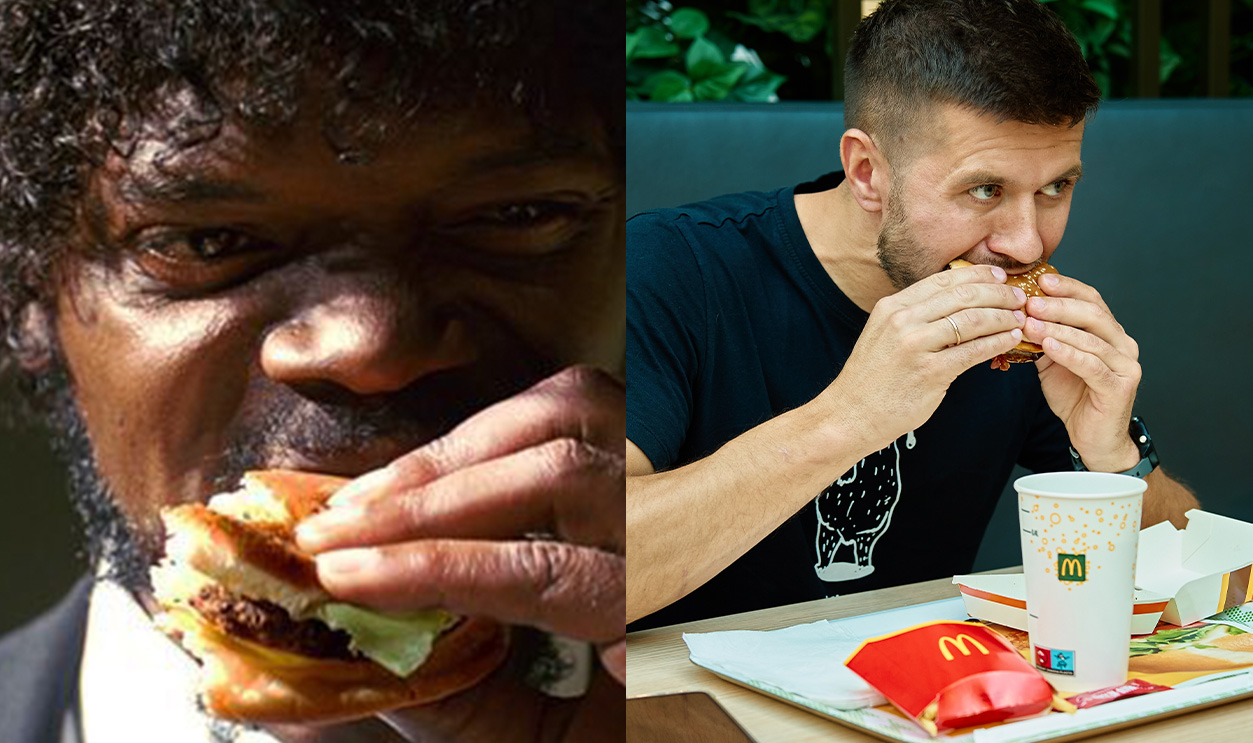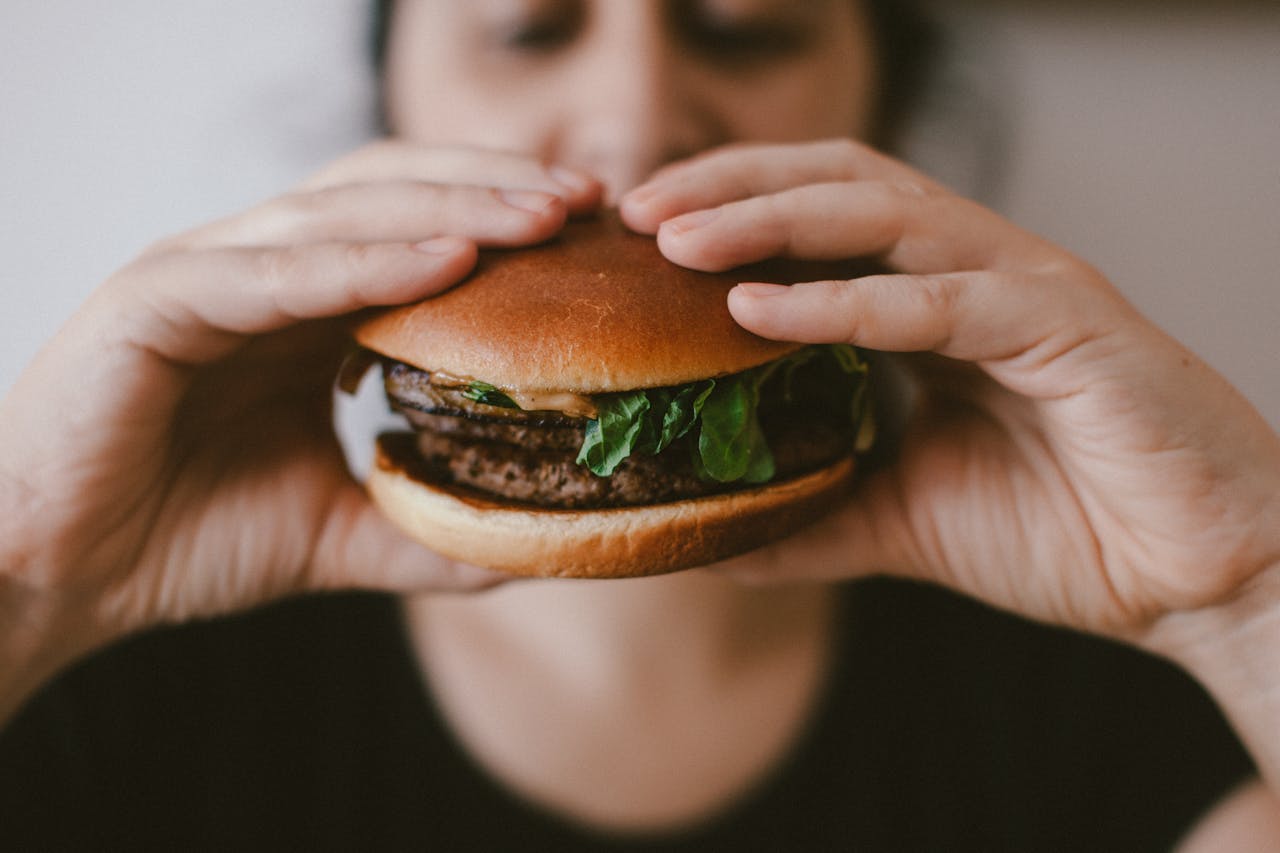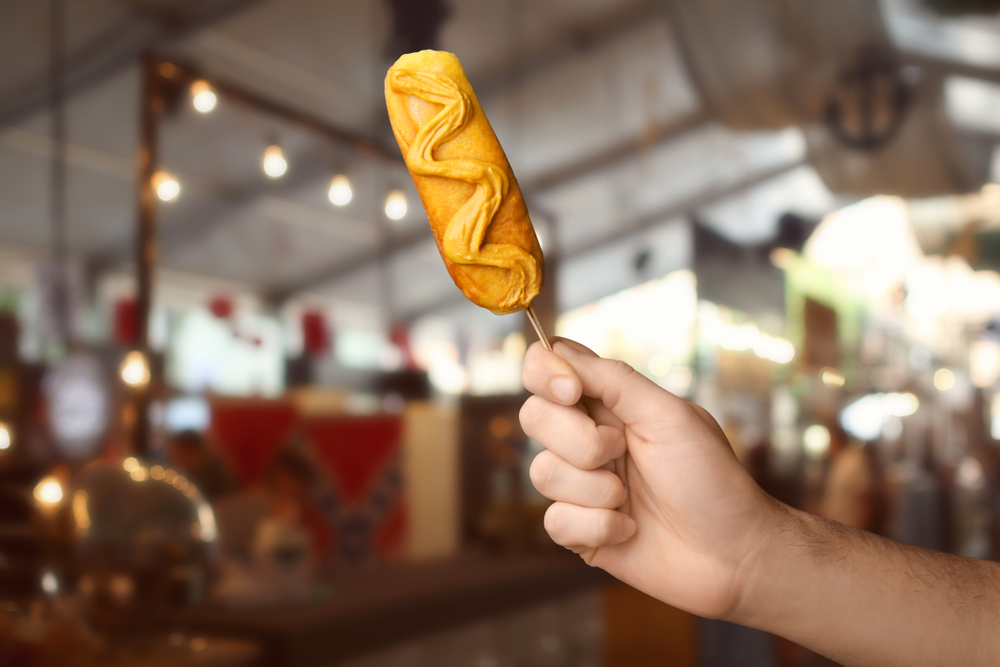Foods You Didn't Realize Were Invented In America
Americans love their food—whether savory or sweet, a juicy steak or a perfectly barbecued pig roast, they rarely pass up an opportunity to devour deliciousness—but what about foods that were created (or certainly popularized) in the United States? Let's take a look at foods invented in America.

Hamburger
The humble hamburger has a mixed history, with claims made by Germany that they were the first country to invent the iconic American dish. But Americans steadfastly claim to be the first inventor of putting a ground beef patty between two pieces of bread, although the name is thought to be associated with a European emigrant's last port before leaving Europe: the German city of Hamburg. A man named Fletcher Davis from Athens, TX, is credited with inventing the "hamburger" during the 1880s.
Corn Dog
Batter a hotdog in cornmeal and deep fry it? That ain't nothin' but a corn dog! Its origins stretch back to 1924, when Francis Matson filed a patent for the classic American breaded dog, minus the stick. In 1929, Stanley S Jenkins filed a second patent for the corn dog that featured the stick necessary for deep frying. Many others have since filed different patents laying claim to the corn dog.
S'mores
Give us s'more of those melted marshmallow things that are a diabetes sandwich. S'mores are something of a campfire classic—with origins stretching back to a 1927 Girl Scout handbook, wherein the original recipe can be found. Loretta Scoot Crew, Troop Leader, gets the credit for inventing the s'more.
Chimichanga
Ever wondered what might happen to a burrito if you fried it? Monica Flin found out in 1922, as she was cooking in her Tucson, AZ restaurant and accidentally tossed a burrito into a deep fryer. She stopped herself from swearing in frustration (as there were children nearby), and instead yelled "Chimichanga!" which translates (roughly) to "whatchamacallit". Thus, the infamous name was born.
Caesar Salad
Beware the Ides! While you may think that Caesar salad has origins dating back to the vaunted Emperor of Rome, it's actually an American dish—well, sort of. It was created by Caesar Cardini in the 1920s, at his restaurant in Tijuana, Mexico, but was popularized after he emigrated to the United States and set up shop in San Diego and Sacramento, California.
Philadelphia Cheesesteak
One does not go to Philly without having a cheesesteak—simply a steak sandwich filled with delicious melted cheese. Philly chef Pat Olivieri is credited with inventing the cheesesteak in the 1930s, despite beginning his career as a hotdog stand operator.
German Chocolate Cake
Why is there a German chocolate cake on a list of foods invented by Americans? Because it isn't German. But its inventor was a woman named Mrs George Calay, who published the recipe in a Dallas newspaper in 1957. The name of the chocolatier who invented the chocolate used in the recipe is Sam German—hence the rather literal name: German chocolate cake.
Cuban Sandwich
Once again, a strange name for something invented in America, but this meaty sandwich was invented by Cuban immigrants to Tampa, Florida in the 1830s. Stacked with roast pork, ham, and Genoa salami, dressed with Swiss cheese, pickles, and mustard—the Cuban sandwich is the official sandwich of the city of Tampa.
Clam Chowder
This creamy soup filled with clams (obviously), other seafoods, potatoes, onions, and other veggies, has its roots among European settlers in New England. There are two variations of clam chowder, the first is "traditional", which features a cream or milk base. Meanwhile, its culinary compatriot in some New England states is made with tomato broth. Clam chowder has its origins in the mid-18th century, first appearing in a Boston newspaper as "New England Chowder".
Spaghetti And Meatballs
While some Italians may consider spaghetti and meatballs to be an American bastardization of the classic Italian dish, spaghetti and meatballs was invented by Italian immigrants to the United States between 1880 and 1920, paired with the classic Italian recipe for meatballs.
Chocolate Chip Cookies
The classic snack of all sweet-toothers everywhere: the chocolate chip cookie. A woman named Ruth Wakefield from Massachusetts is said to have popularized the snack by substituting chocolate chunks for nuts. Working for the Toll House Inn in Whitman, Massachusetts in the 1930s, Wakefield gave them her recipe and they popularized the iconic snack. She later granted Nestle the rights to her recipe and the Toll House name. Wakefield's original recipe can still be found on every bag of Nestle chocolate chips to this day.
Biscuits And Gravy
As the British wince at the phrase, biscuits and gravy is a southern staple that came about during the Revolutionary War (more British wincing). Biscuits were originally a hard, break-your-tooth food, before the addition of baking powder and soda. Gravy was easy to make during the Revolutionary War and combining the two made for a tasty, quick snack in 19th century Appalachia.
Deep-Dish Pizza
"Deep-dish pizza" can otherwise be called "Chicago-style pizza", for its origins in the Windy City in 1943. It was created by two Italian-American chefs, Ike Sewell and Ric Riccardo, when they baked their favorite pizza in a pan—the result was the incredible deep-dish pizza that Chicagoans and visitors to the Windy City know and love.
Pecan Pie
There are mostly just theories as to how pecan pie came to be. One that's most prominent is that French immigrants to New Orleans received pecans from the Native Americans, leading to the creation of the pie. Although, other recipes for pecan pie came out of Texas in the 1870s and 1880s, popularized further by marketing on bottles of Karo corn syrup in the 1930s.
Buffalo Wings
Invented in Buffalo, New York by Frank and Teressa Bellissimo during the 1960s at The Anchor Bar, their recipe for buffalo wings became incredibly popular by the 1980s. However, there's a dispute as to whether they invented them—or if a place just around the corner did, owned by a man named John Young. Young had been tossing his wings in a hot and spicy sauce, but calling them "mambo wings" instead. One thing is certain: Buffalo wings were invented in Buffalo.
Ranch Dressing
Created in California in the 1950s by a man named Steve Henson, ranch dressing featured a creamy buttermilk sauce dressed with various herbs and spices—including salt, garlic, pepper, paprika, and ground mustard seed. Nowadays, the buttermilk sauce is often substituted with yogurt, for a thicker sauce.
Cornbread
A food as old as time itself. Native Americans were the first people to invent cornbread, long before European colonization of the Americas. Today, it comes in many forms and variations and can be eaten as a breakfast bread or as a dessert, depending on the amount of sugar or eggs put in. Almost everyone you meet will have a slightly different take on cornbread.
Key Lime Pie
The origin of Key lime pie can be traced to Key West, Florida and was likely invented by Borden, a producer of condensed milk in 1931. Its original name was the "Magic Lemon Cream Pie," as published by Borden, but by the 1940s, the dish had been renamed "Key Lime Pie". Combining key lime zest with condensed milk, Greek yogurt, a Graham cracker crust, and a creamy, sweet meringue can create this served-cold summer delight.
Tater Tots
What do you do when searching for a way to use leftover shreds of cut-up potato? Throw them in a batter, then bake them, of course. That's what Ross Erin Butler and Francis Nephi Grigg did in 1953, marketing them as "tater tots" under their company name Ore-Ida.
Twinkies
Surely Twinkies are up there as everyone's favorite cake? The golden sponge cake with a cream filling was created in 1930 by James Dewar, a baker for the Continental Baking Company, based in the United States—although Dewar was Canadian! After realizing that machines used for making strawberry-filled cream cakes sat empty during the off-season for the strawberries, he devised a banana-cream filling for the cakes and dubbed them "Twinkies".
Cream Cheese
Invented in 1872, a New York dairyman by the name of William A Lawrence attempted to recreate a classic Neufchatel cheese, but added far too much cream—making it infinitely more spreadable. Borrowing from the popularity of Philadelphia among foodies at the time, he dubbed it "Philadelphia Cream Cheese".
Kellogg's Corn Flakes
The classic breakfast was first invented in 1894 by WK Kellogg. Apparently, Kellogg left behind a batch of wheat-berry dough after a long day and when he came back the next morning, he sent the dough through the rollers rather than throwing it out—thus the flaky product was born. It was originally given to patients at the Battle Creek Sanitarium in Michigan.
JELL-O
Jell-O uses a base of gelatin that's been around since God was a boy, and was invented in 1897 by Pearle White of LeRoy, NY. He was in the midst of creating a cough remedy and a laxative when he mixed powdered gelatin (invented in 1845) and water, while his wife added strawberries, raspberries, and orange and lemon flavorings to give us the favorite lunchbox item of every American child.
Cobb Salad
An eclectic mix of leftovers: That's what the origins of the Cobb salad were! Created in 1937 at the Hollywood Brown Derby restaurant in Los Angeles, chefs threw together a few leftovers—chicken, eggs, avocado, greens, bacon, and tomatoes—and called it a dish, naming it after Robert Cobb, who owned the restaurant. Its characteristics are generally that the salad is served in rows of each food.
TV Dinners
Otherwise known as Sad Meals For One, TV dinners were invented by food company Swanson in 1953, after being left with over 500,000 pounds of turkey following a disappointing Thanksgiving sale. Swanson invented a container that worked as a cooking and serving tray, compartmentalizing various aspects of a turkey dinner, including turkey, sweet potatoes, and peas. The TV dinners debuted in 1953 and sold 10 million units a year later and 25 million in 1955.
The Cronut
Though the French may balk at it, the "cronut" is a croissant-donut hybrid created in 2013 by pastry chef, Dominique Ansel, at his bakery by the same name in New York City. Thus, the "Cronut" was born and has sold like hotcakes ever since.
Muktuk
"Muktuk" is the Native American word given to bite-sized bits of whale skin and blubber, most commonly served raw in Alaska. While the origins are centuries old, Muktuk's fat content is often what helped keep Alaskans alive during the winter. Though it's often served raw, it can also be delicious deep fried.
Jambalaya
A Cajun dish invented in Louisiana in the mid-19th century, Jambalaya was heavily influenced by French, Spanish, and African food and is a combination of meat, seafood, veggies, and wild rice. The variations on the classic dish are endless, but this American classic isn't to be missed if you're anywhere near Louisiana.
Toasted Ravioli
Toasted ravioli was invented in The Hill neighborhood of St Louis, Missouri. It's said to have happened accidentally in the 1940s, after a chef accidentally dropped a raviolo into a fryer, creating the toasted exterior. Charlie Gitto's On The Hill restaurant is generally accepted as being the creator and popularizer of toasted ravioli, which are traditionally served with a meat filling, rather than cheese.
Rueben Sandwich
It's named after Omaha-based chef Rueben Kulakofsky, who created the delicious corned beef sandwich during a poker game in 1920, and topped it with cheese. Soon after, the lunch menu at Omaha's Blackstone Hotel featured the Rueben sandwich and the eponymous dish gained incredible popularity.
Apple Cider Donuts
This interesting take on apple cider was invented in New Hampshire and uses apple cider when baking the donuts to give them that tangy flavor. They were developed in the 1920s by Russian immigrant Adolf Levitt.
Chicken Fried Steak
Yep, that's exactly what it sounds like. Bits of beefsteak coated in a chicken-seasoned batter and either pan-fried or deep-fried. This amalgamation of chicken and beef was invented in the Texas South Plains by German immigrants in the 19th century.
Cinnabon
Imagine looking at a cinnamon roll and thinking: "What if it were much bigger?" Well, that's what the inventors of Cinnabon did, enlarging the traditional cinnamon roll by almost double and then opening a restaurant that served the sugar-filled behemoths. Opening in the SeaTac Mall in Washington in 1985, sugar lovers everywhere now clamor for the gigantic cinnamon rolls.
The Luther Burger
Have you ever made a hamburger, then realized you didn't have any burger buns left? Of course you have. Then, have you ever looked at a bag of sugar donuts and had a lightbulb moment and used those as the bun? No? Well, one chef did at Mulligan's Bar in Georgia, inventing the Luther Burger: a hamburger topped with bacon and cheese, sans vegetables, and sandwiched between two sugar-glazed donuts. Be still, my beating heart.
Bananas Foster
Made with bananas (shockingly), butter, brown sugar, cinnamon, rum, and banana liqueur flambéed and served over ice cream, Bananas foster has its origins at Brennan's Restaurant in New Orleans, created by chef Paul Blangé. This gorgeous dessert is another of NOLA's outstanding contributions to American cuisine.
McDonalds
While, of course, McDonalds is the infamous American fast food, beloved intergenerationally since 1940 and famous for their Big Macs, fries, and thick milkshakes, they're also one of the unhealthiest American fast food inventions you'll ever come across. The obesity rate in the United States is a stunning 37.2% and is correlated to the presence of fast food chains like McDonalds, according to a study in the Journal For Preventative Medicine and Hygiene.
Have you had any of these American classics? What's your favorite "quintessentially American" dish? Let us know in the comments.

